

Find out in this report how the two Cloud Detection and Response (CDR) solutions compare in terms of features, pricing, service and support, easy of deployment, and ROI.
| Product | Market Share (%) |
|---|---|
| Sysdig Secure | 6.3% |
| Check Point CloudGuard Cloud Intelligence and Threat Hunting | 1.3% |
| Other | 92.4% |

| Company Size | Count |
|---|---|
| Small Business | 6 |
| Midsize Enterprise | 2 |
| Large Enterprise | 5 |
Check Point CloudGuard Cloud Intelligence and Threat Hunting offers advanced analytics and threat detection for cloud environments, streamlining security management and enhancing threat prevention capabilities.
Designed for enterprises seeking robust security solutions, Check Point CloudGuard Cloud Intelligence and Threat Hunting leverages machine learning to analyze potential threats in cloud infrastructures. This tool enhances cloud security postures by identifying suspicious activities and providing deep insights, aiding security teams in responding to threats efficiently. It integrates seamlessly with existing security setups, offering comprehensive threat visibility and streamlined threat management.
What are the key features of Check Point CloudGuard Cloud Intelligence and Threat Hunting?In industries like finance and healthcare, Check Point CloudGuard Cloud Intelligence and Threat Hunting is implemented to safeguard sensitive data while ensuring compliance with regulatory standards. Its capabilities are crucial for maintaining high security in dynamic and data-sensitive environments, where vigilant threat detection and quick response are critical.
In the cloud, every second counts. Attacks move at warp speed, and security teams must protect the business without slowing it down. Sysdig stops cloud attacks in real time, instantly detecting changes in risk with runtime insights, a unique AI architecture, and open source Falco. Sysdig delivers live visibility by correlating signals across cloud workloads, identities, and services to uncover hidden attack paths. By knowing what is running, teams can prioritize the vulnerabilities, misconfigurations, permissions, and threats that matter most. From prevention to defense, Sysdig helps enterprises move faster and focus on what matters: innovation.
Sysdig. Secure Every Second.
We monitor all Cloud Detection and Response (CDR) reviews to prevent fraudulent reviews and keep review quality high. We do not post reviews by company employees or direct competitors. We validate each review for authenticity via cross-reference with LinkedIn, and personal follow-up with the reviewer when necessary.